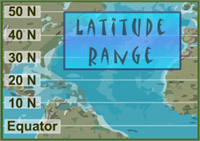
Map of the Atlantic Ocean bordered by West Africa on the right, the northern part of South America in the lower left corner, Central America along the left side, and North America in the upper left corner. The Equator line is drawn across South America. The 10 degree north latitude line is drawn across the northern tip of South America. The 20 degree north latitude line crosses the central Caribbean Sea over the Atlantic to Central West Africa. The 30 degree north latitude line crosses the Atlantic from Northern Florida to Northern Africa. The 40 degree north latitude line crosses the Atlantic from New England to Portugal and Spain. The 50 degree north latitude line crosses from Newfoundland to the British Isles.
A blue box with the label "Latitude Range" stretches across the Atlantic Ocean.
Cartoon drawing of a big thermometer that reaches from the sea surface down to 50 meters depth. A label says "Sea temperature in the top 50 meters: 21.5° C." That's just an arbitrary temperature on the thermometer now. Answer the question on the previous page to estimate the correct temperature for forming hurricanes.
When we talk about "sea surface temperatures," we're really talking about the average temperature in the top 50 meters of water.
Three layers of the atmosphere above the sea are labeled upper, middle, and lower. The upper layer has a second label that says, "Upper layer can be dry or moist." The other two layers are labeled dry. Next to each of these is a pair of up and down arrows, which are used in the multimedia version of this module to change the amount of moisture from dry to medium, moist, or very moist.
Three levels of the atmosphere are labeled upper-level winds, mid-level winds, and lower-level winds. Each layer has a compass dial indicating the direction and a rectangular label indicating the wind strength. In this example (which isn't right for hurricane formation, by the way) the upper-level winds are blowing strong out of the northwest, the mid-level winds are strong out of the east, and the low-level winds are strong out of the south. Next to each of these are some arrows, which are used in the multimedia version of this module to change the wind direction and strength.
A satellite image of a large hurricane.